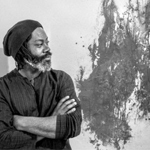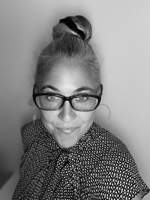Dialogue(s) with Stanley Wany
By: ArtBank / 21 September 2023Dialogue(s) is a captivating conversation program that brings together artists and cultural workers from diverse backgrounds to engage in meaningful discussions. Two works from the Art Bank collection will be rotated through the space at L’Imagier Exhibition Centre—one in June 2023 and one in January 2024. They are also included in the exhibition Coming into Sight: 50th Anniversary Art Bank Acquisitions, presented in the Âjagemô Exhibition Space until May 2024. These artworks were acquired following the open call for purchases announced in June 2022.

Leah Snyder and Stanley Wany engage in conversation at L'Imagier Exhibition Centre. Photo: Brandon Clarida Image Services
When I was approached to participate in Dialogue(s), I suggested Montréal-based artist Stanley Wany as I had a hunch that he would provide an engaging interchange of ideas. Not only was my hunch affirmed, but Stanley exceeded my expectations as a partner in a dialogue addressing colonization and climate change. As our planet heats up, it is imperative to understand the link between the conversion of Indigenous land into colonies for European empires, the transatlantic slave trade and what we now face on the edge of climate collapse. Our conversations in preparation for the June 29 event at L’Imagier corresponded with the forest fires that have forced people back into isolation inside their homes. We could escape the smoke but other species could not. With this background of smoke-filled skies and climate grief, Stanley and I embarked on a journey to consider new metaphors for our troubled times.
I became more aware of Stanley’s work through his 2022 exhibition, For Those Who Chose the Sea, at the Ottawa Art Gallery. Ink drawings lined a wall in the space. A large, interactive structure representing the lower deck of a ship’s hold along with an accompanying media work of the waves of the Atlantic evoked the experience of the Middle Passage. The drawings documented the lost identities of the individuals enslaved by colonial empires for the transatlantic slave trade. Those who survived found themselves captive and displaced on the islands of the Antilles as well as the Americas.
In another 2022 exhibition, Opacity: Obscured Meaning at BAND (Black Artists’ Network in Dialogue), in Toronto, the works asserted the presence of the descendants of the enslaved, real and fictional. In this series of ink drawings, Stanley “follows in the footsteps of African-American artist Jack Whitten by invoking the essence of people without representing their faces or bodies.” This strategy of abstraction also considers theorist Édouard Glissant’s concept of opacity and how it pertains to notions of race, the prerequisite for persons of colour to be categorized in order to be legible to the colonizer. Glissant asserted opacity as one’s capacity to obscure meaning and exist outside of the colonial definition(s) as unknowable and opaque.
“Who might we consider as our ancestors?”
The series at BAND included what Stanley has referred to as “anti-portraits” of exiled Cuban writer René Depestre, Bigger Thomas (the main character of Richard Wright’s 1940 American novel, Native Son), as well as Suzanne Césaire. The wife of renowned Martinican poet Aimé Césaire, she was notable in her own right as one of the voices rising, as with her husband, Glissant and Frantz Fanon, as part of the decolonial momentum produced by Francophone writers from Martinique. The materials Stanley uses for the works reference the trade products associated with colonization: sugarcane, cotton and coffee. The work acquired by the Art Bank, Ancestry, is part of the series and “speaks of intergenerational trauma and representations of Black women in the past century.”
Stanley’s emphasis on the role of ancestors in his practice prompted me to ask who we might consider as our ancestors. Are ancestors only biological? Or are they also our intellectual and creative predecessors whose values we align with and expand on?
 Stanley Wany, Ancestry (2019-2020). Photo: Brandon Clarida Image Services
Stanley Wany, Ancestry (2019-2020). Photo: Brandon Clarida Image Services
Colonization and climate change
Out of the ideas seeded by these Martinican forebears comes the concept of “decolonial ecology” as articulated by environmental engineer Malcom Ferdinand, also from Martinique, whose own writings look at ecology through the filter of race. Referencing the 2020 forest fires in the Amazon and Australia in his talk, “Voices from the Hold of Modernity,” he states, “The fires we are witnessing today may have started long ago.” His research considers the connection between colonization and climate change, what he refers to as the “double fracture.”
Ferdinand also addresses how environmental activism fails to include the experts and critical voices from countries that were the former colonies. In these places, technologies, like those for forest fire management, already existed, as did sustainable practices. He suggests that the societal values that led to the triangle of trade, connecting Europe, Africa and the Americas during the transatlantic slave trade persist in who and what is (de)valued. The European slave trade consumed forests for plantations; settler colonialism in Australia and the Americas consumed—and continues to consume—forests for resources.
In the Antilles, or what we now call the Caribbean, intensifying hurricanes symbolize climate change. In this “climate storm” or “modern tempest,” Ferdinand proposes we consider what kind of boat we will build to weather it. His critique is that as a metaphor used in ecology circles, Noah’s Ark is not the vessel we should consider as it is one of a “violent section.” Not everyone, or even all species, made it inside the hold. For Ferdinand, it is a story about worth, and the power who deems it, as well as “which voices are heard and which are silenced and drowned.”
The ancestors in Stanley’s portraits, the abstracted and emergent, named and unnamed, are the referents foundational to his practice, including the many voices who contributed to decolonization in the Caribbean and whose contribution had global impact. As a constellation of individuals, they collectively offer other ways to resolve the double fracture and build a different kind of vessel, one more robust for our times.

About the Artist: Stanley Wany
Stanley Wany lives and works in Montréal, where he is pursuing a Master of Fine and Media Arts at UQAM. His practice, which explores identity and cultural myths, includes drawing, painting, installation and experimental graphic novels. His works have been presented and acquired in Canada, Australia, the United States, Finland, France and Portugal.

About the Author: Leah Snyder
Leah Snyder is a digital designer and writer with a focus on how artists and art institutions use virtual spaces and digital technology for cultural transformation. She is currently based in Ottawa, a city with a thriving arts community she has come to appreciate and adore.